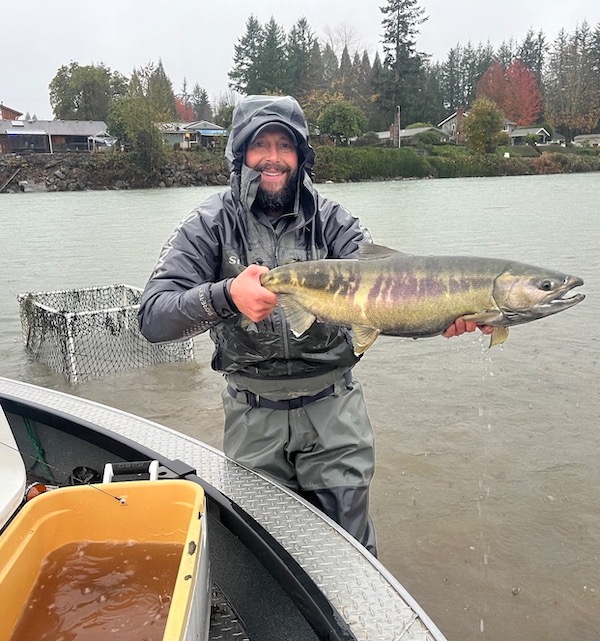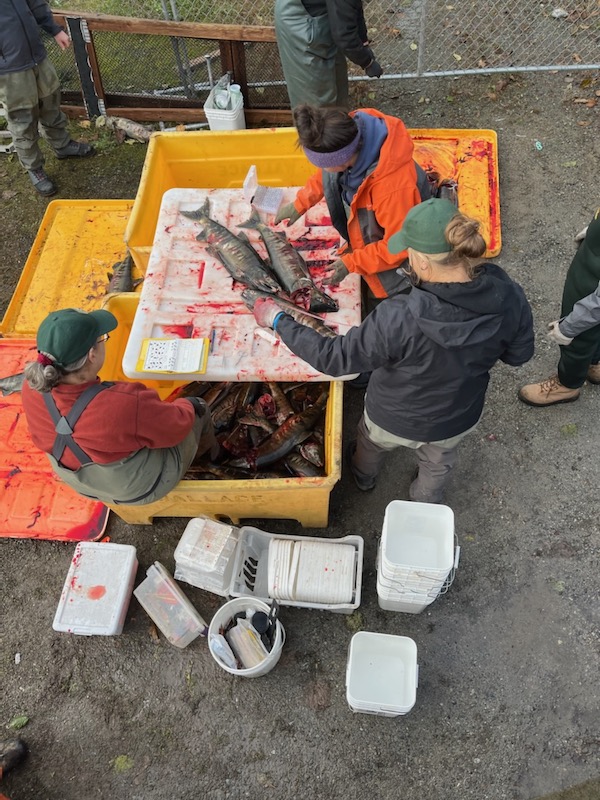
Anglers, Guides, Tribes, WDFW Work To Restore Skykomish Chum Run
THE FOLLOWING IS A WASHINGTON DEPARTMENT OF FISH AND WILDLIFE BLOG
With November storms arriving in force and heavy rain filling rivers across Western Washington, chum salmon have been surging into many waterways, their iconic snaggleteeth and purple tiger stripes as sure symbols of late fall in the Pacific Northwest as soggy fallen leaves.
Because they typically spawn in small creeks and side-channels, chum provide accessible opportunities for those wishing to see the salmon migration in person, including in urban and suburban areas such as Piper Creek in North Seattle, Chico Creek near Bremerton, Kennedy Creek near Olympia, and Twanoh State Park near Belfair. Check out our webpage for places to view chum and other salmon.

Once derided as “dog salmon” fit only for pet food, chum have slowly gained culinary acceptance, with fresh fish marketed as “keta salmon” (from their scientific name Oncorhynchus keta) and smoked or grilled to highlight their mild flavor and flakey meat. Chum eggs are used for “ikura” (marinated salmon caviar), which is prized in sushi restaurants, relatively simple to make at home, and often served on rice or even scrambled eggs.
Chum are also a popular quarry for fishermen due to their powerful fight and tendency to be aggressive biters. In rivers and tidewater, they’ll readily attack chartreuse, pink, or purple lures, flies, or jigs (often tipped with cured shrimp), while anglers in the saltwater target them with bait such as anchovies, herring, or by slowly trolling plastic squid.
Several marine areas remain open for chum fishing and retention, while bait, gear and retention rules vary by river system. Check out our video for chum fishing tips, and be sure to review fishing regulations or the Fish Washington mobile app before hitting the water.
Partnering to restore a run
One river where chum salmon were historically abundant is the Skykomish in Snohomish County, which flows out of Stevens Pass and the rain-soaked western foothills of the Cascade Mountains, joining with the Snoqualmie to form the Snohomish River.
By the early-2000s chum runs in the Snohomish Basin had seriously declined. WDFW and tribal co-managers, including the Tulalip Tribes, had been attempting to jumpstart chum recovery through hatchery programs but were facing issues sourcing wild broodstock due in part to the Skykomish River’s notoriously dynamic flows.
Beginning in 2018, a group of fishing guides led by Charlie Cooper, as well as other local anglers, approached WDFW about helping to catch chum from the Skykomish and transfer them to WDFW’s Wallace River Hatchery.
“Edward Eleazer (Regional Fish Program Manager) and I got to talking about how the chum run was tanking,” said fishing guide Charlie Cooper. “We wanted to supplement the run, but needed to use chum stock from within the basin. I knew guides and anglers would be glad to help collect fish to begin supplementation.”
Similar programs had worked well on other Washington rivers, and with support from state and tribal fisheries co-managers and careful monitoring by WDFW biologists and hatchery staff, collection of Skykomish chum broodstock quickly got underway.
Cooper says that between logistical challenges and low chum returns the first few years were tough, but the program improved over time, including through the support of Matt Kennedy of the Snohomish Sportsman’s Club.
Fast forward to 2022, and chum spawned from this collaborative program are now returning to the Skykomish and its tributaries. Collecting the broodstock has become a major focus of the tight knit “Sky River Anglers” community. Fishermen and women clad head-to-toe in rain gear are putting their jetsleds, jigs, and plugs to work for salmon conservation, using mesh fish bags or aerated coolers to carefully transport live chum to holding pens, and then on to waiting hatchery trucks.
The goal this year is for the local guides and anglers to transfer a total of 500 chum (250 males and 250 females) from the Skykomish to the Wallace River Hatchery near Sultan. After their eggs (roe) and sperm (milt) are extracted and mixed for reproduction, a DNA sample, scale sample and otolith are taken from each fish as part of monitoring the program’s success (otoliths or “ear bones” are located near a fish’s brain and can be used to identify or age salmon, much like the rings of a tree).
From this broodstock, WDFW hatchery staff will produce and rear up to 2 million chum salmon smolts, which will then be released back into the Skykomish River next spring to return in three to four years.

A model of collaboration
While more monitoring and scientific research is needed to determine exactly how effective the Skykomish broodstock program has been for restoring the river’s chum run, the effort has already been successful as a model of collaboration between local guides, anglers, tribes, and WDFW.
“We’re grateful to all the guides and anglers who’ve volunteered their time, money in boat gas and equipment, and fishing expertise to acquire broodstock to help jumpstart chum recovery in the Skykomish,” said Trevor Jenison, WDFW’s Hatchery Operations Manager.
“It’s been a great example of different people who care about salmon partnering, rolling up their sleeves, and getting to work for recovery, and we’re excited to see how the chum run responds in the future,” says Jenison.
Fishing guide Cooper says the program goes beyond salmon harvest or even catch and release. “It’s about restoring a run and supporting our local environment. Chum are so important as food for eagles and other species during the late fall and winter.”
“The big takeaway I have from this program is that if you see a problem on your local river, don’t just complain about it. Contact fish and wildlife, talk to your fellow anglers, and work together to try to find a solution.”
Back on the Skykomish, its gray-green waters swollen by November rains, chum salmon — some spawned naturally in the river’s gravel, others produced from the broodstock that anglers caught and transferred to the WDFW hatchery — are steadily making their way upstream, completing their epic life cycle and providing hope for the rebound of a run.
For how to participate in the Skykomish chum broodstock collection program, follow the Sky River Anglers group on Facebook, or listen to an interview with Matt Kennedy on the Nov. 5 episode of local ESPN radio show The Outdoor Line.


